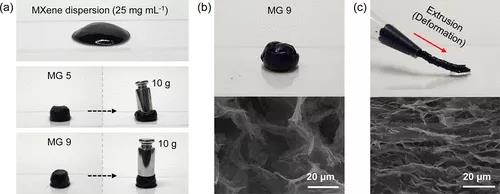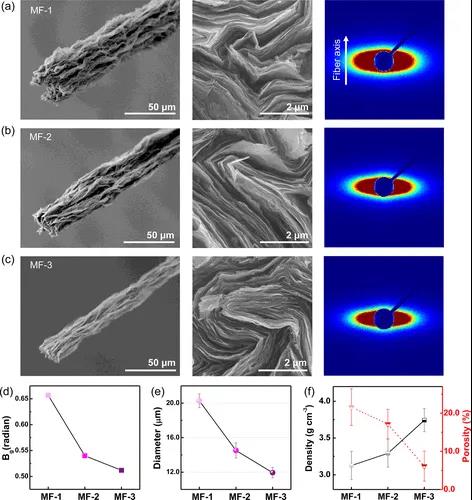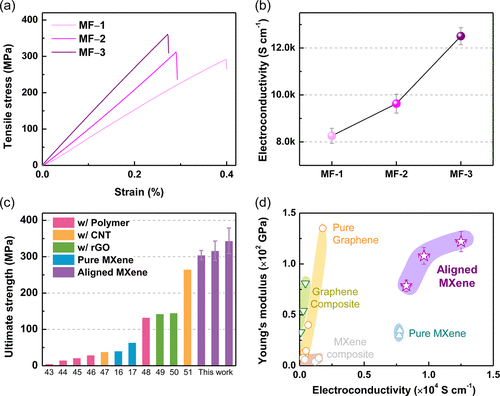
hotline:
17715390137
Tel/Wechat:
18101240246 (Technology)
0512-68565571
Email:mxenes@163.com (Sales Engineer)bkxc.bonnie@gmail.com
Scan the code to follow or search the official account on WeChat:
2D Materials Fronrier After paying attention,
click on the lower right corner to contact us,
Enter enterprise WeChat.
Professional Services Online

 Two-dimensional (2D) nanomaterials have become the subject of intensive research in recent years due to their outstanding physical, chemical and electronic properties. The inherent anisotropy of two-dimensional nanomaterials makes it easy to assemble in a preferential direction and becomes a promising base material for building multilayer macrostructures such as films and fibers. However, structural defects (including microscopic voids, nanoscale boundaries, and local disordered arrangement of building units) can reduce the performance of components. Achieving a perfectly aligned, highly oriented, and defect-free assembly structure is essential for achieving ideal electrical conductivity and mechanical properties. Ti3C2Tx MXenes are composed of transition metal nitrides and carbides. Due to their electrical and thermal conductivity, mechanical and chemical properties, they have a wide range of potential applications (such as supercapacitors, sensors and transparent electrodes). The defect-free MXene structure can increase the conductivity, which can be achieved by controlling the fluid gradient by inducing shear (ie stretching) on the gel phase. However, the strength of the Ti3C2Tx MXenes gel network is not strong enough to withstand shear deformation, and due to the lack of strong interaction (such as chemical bonding) and the short length of its components, it is easily broken due to mechanical disturbance.
Two-dimensional (2D) nanomaterials have become the subject of intensive research in recent years due to their outstanding physical, chemical and electronic properties. The inherent anisotropy of two-dimensional nanomaterials makes it easy to assemble in a preferential direction and becomes a promising base material for building multilayer macrostructures such as films and fibers. However, structural defects (including microscopic voids, nanoscale boundaries, and local disordered arrangement of building units) can reduce the performance of components. Achieving a perfectly aligned, highly oriented, and defect-free assembly structure is essential for achieving ideal electrical conductivity and mechanical properties. Ti3C2Tx MXenes are composed of transition metal nitrides and carbides. Due to their electrical and thermal conductivity, mechanical and chemical properties, they have a wide range of potential applications (such as supercapacitors, sensors and transparent electrodes). The defect-free MXene structure can increase the conductivity, which can be achieved by controlling the fluid gradient by inducing shear (ie stretching) on the gel phase. However, the strength of the Ti3C2Tx MXenes gel network is not strong enough to withstand shear deformation, and due to the lack of strong interaction (such as chemical bonding) and the short length of its components, it is easily broken due to mechanical disturbance.
Based on this, Tae Hee Han of Hanyang University in South Korea developed a strategy to strengthen the MXene gel network to make it stable enough to withstand mechanical interference. Controlling pH can enhance the electrostatic interaction between MXene plates. MXene gel deforms stably in the direction of external shear stress, and the gel has sufficient mechanical strength to withstand the deformation. This enhanced gel network is very beneficial for making perfectly aligned fibers. During MXene solution wet spinning, the MXene sheet is assembled into gel fibers, which spontaneously transform into highly aligned fibers under the action of mechanical stretching force. Oriented MXene fibers have high electrical conductivity (12504 S cm –1) and strong Youngs modulus (122 GPa). This structural design method provides a general strategy for preparing high-performance fibers and controlling the molecular interaction between colloidal particles to induce a strong and deformable gel network. The result "Highly Electroconductive and Mechanically Strong Ti3C2Tx MXene Fibers Using a Deformable MXene Gel" was published in the journal ACS Nano. Synthetic MXene tablets and gelation of MXene
The author synthesized MXene flakes from MAX phase powder by selectively etching the Al layer, with an average lateral size of 3.99±2.62μm and a thickness of approximately 2.14 nm. There are C–Ti–Fx, C–Ti-(OH)x and C–Ti–Ox terminal groups on the surface of MXene, so Ti3C2Tx is negatively charged and exhibits hydrophilic properties. Its Zeta potential is related to pH, and there is a strong electrostatic repulsion between adjacent sheets. Controlling the electrostatic interaction can induce the bonding of MXene sheets. NH4+ ions interact with the MXene sheet, and the MXene dispersion forms a hydrogel through electrostatic interaction (Figure 1d). MXene gel exhibits a stable self-supporting structure (Figure 1E).

Figure 1. Synthetic MXene sheet and gelation of MXene. (A) SEM and (b) AFM images of MXene monoliths coated on SiO2 wafers using Langmuir-Blodgett technology. (C) TEM image and EDX element mapping of MXene single layer. (D) Gelation of MXene. (E) MXene gel image. The mechanical properties of MXene and its gel can enhance the MXene gel network by enhancing electrostatic interaction. The author synthesized MXene gel under different pH conditions (5 and 9), placed a 10 g weight on the gel, MG 5 collapsed, and MG 9 had no structural fracture, indicating the strong attraction between MXene tablets at high pH Enhance the structural stability of the gel (Figure a). MG9 is not only stable in structure, but also capable of deforming under external force. The internal structure can be well aligned through the shear stress generated by the extrusion of the plastic nozzle (Figure 2 b and c).





| Reminder: Beijing Beike New Material Technology Co., Ltd. supplies products only for scientific research, not for humans |
| All rights reserved © 2019 beijing beike new material Technology Co., Ltd 京ICP备16054715-2号 |